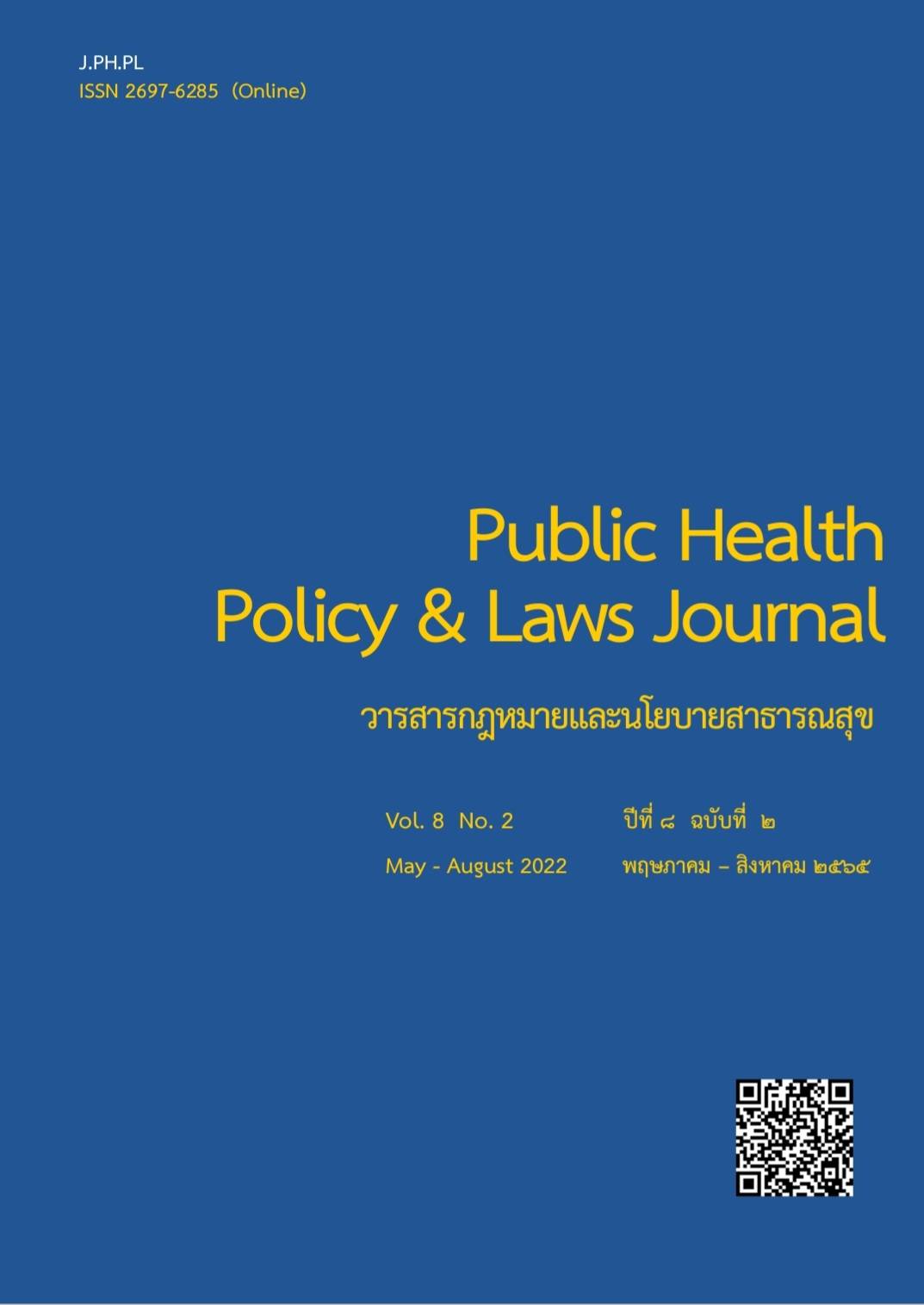Hybrid Learning Design in Statistics and Research in Health Management for Graduate Students during the COVID-19 outbreak
Keywords:
Hybrid learning, Learning design, Statistics and research in health management, COVID-19Abstract
This action research aimed to design a hybrid learning model and evaluate the educational achievement of the statistics and research in health management course. The research process was divided into 4 phases: phase 1, Planning Stage, phase 2, Operational Stage, phase 3 Observation Stage, and phase 4 Reflection Stage. And also study success factors. The study was conducted among all 61 students who enrolled in the Statistics and Research in Health Management Course and 4 instructors. Data were collected by using questionnaires. The statistics used in the data analysis were percentage, mean, standard deviation and independent t-test
The results of the study showed that during the COVID-19 outbreak students and teachers have a preference for hybrid learning, and the problem encountered with hybrid teaching and learning is the difficulty in using technology. There were suggestions that there should be prepared in the use of technology for both teachers and students and increase communication channels. However, when evaluating the hybrid learning achievement, it was found that the hybrid group had higher scores than the face-to-face group alone. Both in terms of test scores and collect scores the statistical significance at the 0.05 level for the assessment of student and teacher satisfaction with the hybrid teaching and learning management was found that the students and teachers were satisfied with the hybrid learning method. Overall and each aspect is at a high level in every aspect. The success factor in hybrid learning is designing activities that allow students to participate or have a clear agreement between teachers and students. preparation of both learners and instructors, especially in terms of using programs that are used to teach online, the convenience of staff and quick communication, and being able to review knowledge by studying online retrospectively.
References
ประกาศกระทรวงการอุดมศึกษา วิทยาศาสตร์ วิจัยและนวัตกรรม เรื่อง มาตรการและการเฝ้าระวังการระบาดของโรคไวรัสโคโรนา 2019 หรือโรคโควิด-19 (Coronavirus Disease 2019 (COVID-19)) (ฉบับที่ 3): การปฏิบัติการของสถาบันอุดมศึกษาเพื่อป้องกันการแพร่ระบาดของโรคโควิด-19. (2563). อนุสารอุดมศึกษา. 46(502). 4.
ชัยวัฒน์ สุภัควรกุล, สุทธิพงศ์ หกสุวรรณ และนิคม ชมภูหลง. (2560). การพัฒนาระบบการเรียนการสอนแบบไฮบริด สำหรับนักศึกษาระดับปริญญาตรีมหาวิทยาลัยราชภัฏ. วารสารการวัดผลการศึกษา มหาวิทยาลัยมหาสารคาม. 23(1). 66-77.
พิจิตรา ธงพานิช. (2560). วิชาการออกแบบและการจัดการเรียนรู้ในชั้นเรียน. พิมพ์ครั้งที่ 3. นครปฐม: โรงพิมพ์มหาวิทยาลัยศิลปากร วิทยาเขตพระราชวังสนามจันทร์.
มหาวิทยาลัยศิลปากร. (2557). รายงานการวิจัยเรื่องแนวทางการพัฒนาอิเลร์นนิ่งสำหรับสถาบันการศึกษาไทย การนำเสนอแนวทางการจัดการเรียนการสอนแบบผสมผสานที่ใช้ ubiquitous – learning เป็นเครื่องมือการเรียนรู้. สืบค้นจาก http://www4.educ.su.ac.th/images/research/57/04.pdf
การจัดการเรียนรู้แบบผสมผสาน. วารสารศิลปากรศึกษาศาสตร์วิจัย. 13(1). 77-94.
พระราชบัญญัติ มหาวิทยาลัยสุโขทัยธรรมาธิราช พ.ศ. 2521. (2521, 21 กันยายน). ราชกิจจานุเบกษา. เล่ม 95 ตอนที่ 99 ก. หน้า 1-15.
ศิวาพัชญ์ บำรุงเศรษฐพงษ์ , ภูริสร์ ฐานปัญญา และ เกรียงไกร สัจจะหฤทัย. (2563). การเรียนการสอนแบบไฮบริด (Hybrid Learning) กับการพัฒนาคุณภาพการศึกษาไทยในศตวรรษที่ 21. วารสารนาคบุตรปริทรรศน์ มหาวิทยาลัยราชภัฏนครศรีธรรมราช. 12(3), 212-224.
สมใจ จันทร์เต็ม. (2553). Hybrid Learning กับนวัตกรรมการเรียนการสอนวิชาบัญชีในศตวรรษที่ 21: กรณีศึกษาของมหาวิทยาลัยหอการค้าไทย. วารสารวิชาการ มหาวิทยาลัยหอการค้าไทย, 30(1), 134-150.
สาขาวิชาวิทยาศาสตร์สุขภาพ. (2563) แผนกิจกรรมการศึกษาชุดวิชา 50703 สถิติและการวิจัยในการจัดการสุขภาพ. (อัดสำเนา).
สำนักบัณฑิตศึกษา ฝ่ายส่งเสริมมาตรฐานบัณฑิตศึกษา. (2564). คู่มือนักศึกษาระดับปริญญาโท มหาวิทยาลัยสุโขทัยธรรมาธิราช. สืบค้นจาก https://www.stou.ac.th/thai/grad_stdy/Masters/CD/
คู่มือนักศึกษา%20ป.โท%20ปี%202564.pdf
อารี ชีวเกษมสุข. (2564).การจัดการเรียนการสอนทางการพยาบาลด้วยการเรียนรู้แบบผสมผสาน ในยุคความปกติใหม่. วารสารวิจัยสุขภาพและการพยาบาล. 37(1). 25-37.
Hariadi, B., Sunarto, D., Sudarmaningtyas, P., & Jatmiko, B. (2019). Hybrid Learning by Using Brilian Applications as One of the Learning Alternatives to Improve Learning Outcomes in College. International. Journal of Emerging Technologies in Learning. 14(10). https://doi.org/10.3991/ijet.v14i10.10150.
Caulfield, J. (2011). How to Design and Teach a Hybrid Course. Sterling, VA: Stylus.
Huba, M .E., & Freed. J. E. (2000). Learner-Centered Assessment on College Campuses. Boston: Allyn & Bacon.
Snow, K. (2016). Opting In or Opting Out: The Role of Hybrid Learning Course Design on Student Persistence Decisions in an Indigenous Pre-Nursing Transitions Program. International Journal of E-Learning & Distance Education, 32(1), 1–14. Retrieved from https://search.ebscohost.com/login.aspx?direct=true&db=eue&AN=117079586&site=eds-live.
Linder, K.E. (2017). Fundamentals of Hybrid Teaching and Learning. Teaching and Learning. 2017, 11-18. https://doi.org/10.1002/tl.20222
Kemmis, S & McTaggart, R. (1988). The Action Research Planner. 3rd ed. Victoria, Australia: Deakin University
Koehler, M.J., & Mishra, P. (2008). Introducing TPCK. In Handbook of Technological Pedagogical Content Knowledge (TPCK) for Educators. New York: Routledge.
Cremers, P.H.M., Wals, A.E.J., Wesselink, R & Mulder, M. (2016). Design Principles for Hybrid Learning Configurations at the Interface between School and Workplace. Learning Environ Res.19
Downloads
Published
How to Cite
Issue
Section
License
Disclaimer and Copyright Notice
The content and information presented in articles published in the Journal of Law and Public Health Policy represent the opinions and sole responsibility of the respective authors. The editorial board does not necessarily agree with or assume any responsibility for the views expressed.
All articles, data, content, images, and other materials published in the Journal of Law and Public Health Policy are the intellectual property of the journal. Any individual or organization wishing to reproduce, distribute, or otherwise use the entirety or any part of such materials must provide proper citation.





